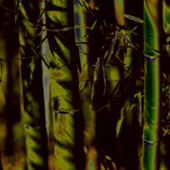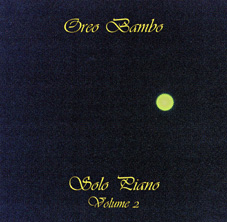|
Oreobambo
|
|
Solo Piano, Volume 2
Music Composed and Performed by Oreobambo Inspired by the Stars |
|
EM Productions 1999
|
|
Total Length 48':48''
|
Copyright ©1999 Oreobambo
The Mysterious Sounds of Oreobambo
Oreobambo Solo Piano, Volume 2
In the many well known music concert halls of the world that are renowned and frequented as the temples of classical music (the music already defined as ‘serious music’ or ‘good music’ by season ticket holders, music lovers, melomaniacs, the excessively zealous and leftovers of the so called historical ‘avant-garde’), it would be hard to predict what effect upon an audience a live performance of the sixteen pieces that make up Oreobambo’s Solo Piano Vol. 2 would have.
Oreobambo is a name which at first brings to mind the idea of a tributary in the Amazon basin, while in a child’s imagination it might trigger the image of a character of Emilio Salgari’s ‘Black Jungle’.
It is instead the composer of a peculiar and extremely fascinating series of musical works. Solo Piano Vol.2 is the fourth in this collection including Lymantria, (his debut opus), Scintillans and Solo Piano.
In this work the piano does not seem to have the physical and human reality of mechanical percussion. Rather, one hears a succession of hypnotic sonorities that are often constructed upon two autonomous ‘monodies’, entrusted to two hands that contrast and blend in a weave between the high and low registers. Even the use of the so called ‘contrary motion’ of various pieces springs from an ‘ostinato bass’ (of formal traditional structure) whose rhythm seems to have a kind of destiny beyond the personal, almost a presence that announces “the” impending event.
All these events are presented and developed outside of and beyond all the rules of orthodox tonal harmony, the bipolar modalities (major and minor), and even completely skipping over the twelve-tone style which sees its maximum epigone in Schöenberg in the twentieth century. It’s worth noting Matteo della Rovere’s comments on Oreobambo in his review of Lymantria: “...he is not particularly interested in modality though he does utilize modes...” and also “...there is a marked avoidance of pre established forms, with a preference for free and adventurous musical thought...”
In fact in various pieces in this last work we recognize vague transfigured reminiscences (almost residual of an instinctive process of selection) of the ‘hexatonal’ world of the major French Impressionists. These forms then materialize and expand into dithyrambs proper to the stylistic elements of the popular music of Bèla Bartók and Zóltan Kódaly, in which characteristic chants of folk origin are passed on through the centuries from father to son vocally and instrumentally.
That which I have said thus far obviously represents the usual didactic mode of analyzing a work of art. It would not be appropriate to continue in this vein as Oreobambo has written music which does not allow us to use a ‘critical system’ that is rooted in the musical culture which has permeated our civilization until now. His music gives us a sense of gratification and fulfilment, but also creates a sense of inadequacy in the person who is called upon to define it and discuss it descriptively. This music contains all that cannot be explained through language; something which cannot be said of all written music and certainly not of that which uses a bona fide ‘structured language’. In this regard, in presenting Lymantria Matteo della Rovere continues: “The fact is that Oreobambo is interested in music per sé and not in the languages that it employs. Any of these may do...”.
In my opinion this music has almost nothing of the physical and yet it dynamically portrays the mutations of substance. It cannot be described as human and yet it is upheld by an extremely intense poetic force. It seems to come from other worlds which are observing us, and who, through these sounds, wish to build a bridge to us.
We hear sounds that find ephemeral expression through the body and hands of the executioner (Oreobambo himself), which then disperse and blend into the indefinable. I would dare to define it as "Sidereal".
What anthropologist Maria Capaldi writes with regard to Scintillans is perfectly appropriate: “In antiquity "the musician" was a natural and spontaneous phenomenon... an intermediary figure between the world of men and that of the spirits thanks to the sonorous harmony that he managed to produce...“ and she adds with able feminine perception “...this silence disguised as melody introduces the listener into a new and open world. Here musical instruments are steeped in the magic with which they were played in the most remote ancient times, and the executioner is emptied as he plays...”.
One understands these words better while voyaging through each piece, from the fleeting jazz notes of Mirzam (No.5), to the contrapuntal virtuosity of Denebola (No.7), and from the intentional dissolution of the “well-tempered clavier” of Menkalinan (No.8) with its recurring motif to the obsessive and repetitive echoing of Furud (No.11), with its provocative arab-mozarabic modes that spill into a “passacaglia” (a theme with variations), with evocations of Richard Strauss’ Salomè crying out from the abyss. But some pieces are worth further comment:
- Hassaleh/ Diphda (No.9-10) moves us with its simple poetic intensity. Which words could accompany these sounds?! Perhaps the poet Jorge Guillon manages when he writes:
“La tremura del día dominado,
La claridad en coto,
La poseida claridad,
Bajo una profusion de sol difuso”
(From the poem Mas Esplendor from the collection, Aire Nuestro)
- Altair (No.15), with its swirling scales, seems to echo a well-known improvisation by Schubert. It is an homage to the great romantic’s magnificent eighteenth-century style which is then transported into the third millenium upon the wings of a transformative force. Pianist Susanna Capocci writes of Solo Piano: “All of the pieces give expression to a bipolarity of tension between two repetitive melodic lines that support, respond and reinforce each other in their respective processes of exploration...”. Altair appears to us as a carrier heading off on “the” space odyssey.
- Aldebaran (No.16) takes its name from a ‘fixed star’ of great luminosity. Considered by traditional astrology to be a star that has beneficial effects upon all living beings, its name also reflects its nature: Al Dabaran, from the arabic “that which follows the Pleiades”. This stupefying piece is a brief “meteor” that closes the entire work with grandeur, irony and a sense of synthesis.
The music of Oreobambo is unique in its genre, if one can speak here of genres. In parts, it is pleasing and enveloping, while in others it is compulsive and obsessive. It is music that comes from afar and returns into the distance with the force that it has to unite, disrupt and upset. Perhaps it is music with a remarkable ‘naturalistic’ and phenomenal imprint made up of energetic nuclei that accumulate and disintegrate as happens in ‘natural events’: an event which unleashes itself in the cosmos, aware of its frightening and beloved vastness.
Maestro Riccardo Piccirilli
Rome, July 1999
 |
Buy from EM Productions Online Store
Acquistare su EM Productions Online Store
|
|
| ColourfulTone® |

Oreobambo Web Site
Music: Web Licence SIAE n. 2869 /I/ 2806
All Photographs and Music Copyright ©1996/2025 Oreobambo
Web site design and information - Copyright ©1996/2025 EM Productions
All rights reserved. Reproduction in whole or in part is strictly prohibited without express written permission of the copyright holders.







